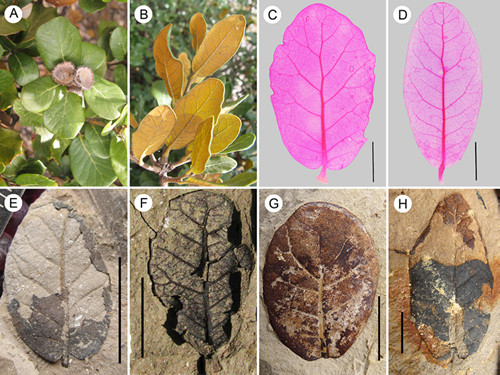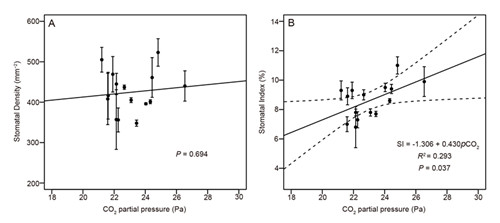palaeoenvironmental information in geological time and also a baseline reference for understanding future climatic change. The inverse relationship between atmospheric CO2 partial pressure (pCO2) and stomatal frequency in many species of plants has been widely used to estimate palaeoatmospheric CO2 (palaeo-CO2) levels. In contrast to the negative correlations detected for most other species that have been studied, the research group led by Prof. ZHOU Zhekun from Kunming Institute of Botany detected a positive correlation between pCO2 and stomatal frequency in Quercus guyavifolia (Q. guajavifolia, Fagaceae, Fig. 1). The “unusual” positive correlations were found from both extant field samples collected from an altitudinal gradient and historical herbarium specimens (Fig 2, 3). Applying these correlations to Q. preguyavaefolia fossils, palaeo-CO2 concentrations are estimated to be approx. 180-240 ppm in the late Pliocene, which is consistent with most other previous estimates. This result shows that the positive relationship between stomatal frequency and pCO2 in Q. guyavifolia is reliable and can be used as a basis to estimate palaeo-CO2 levels.
These research results have been published on line in Annals of Botany titled “A new positive relationship between pCO2 and stomatal frequency in Quercus guyavifolia (Fagaceae): a potential proxy for palaeo-CO2 levels” (The link: http://aob.oxfordjournals.org/content/early/2015/02/13/aob.mcv007.abstract?keytype=ref&ijkey=SF2qBN97g4gGC5g). This work was supported by the National Natural Science Foundation of China (grant no. 41030212) and the National Basic Research Program of China, 973 Program (grant no. 2012CB821901).

Fig. 1. Comparisons of leaf morphology of extant Quercus guyavifolia and fossil Q. preguyavaefolia.

Fig. 2. Relationship between stomatal frequency and CO2 partial pressure of Quercus guyavifolia extant field collections.

Fig. 3. Relationship between stomatal frequency and CO2 partial pressure of Quercus guyavifolia historical herbarium specimens.




